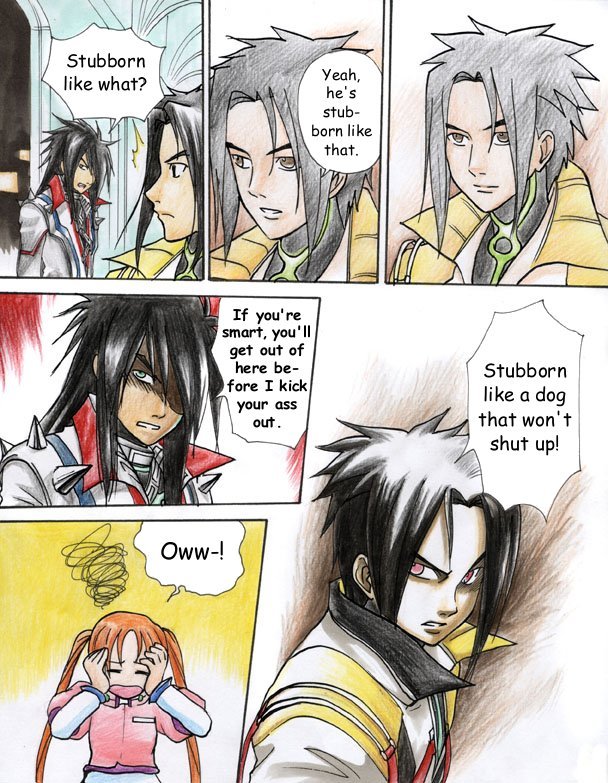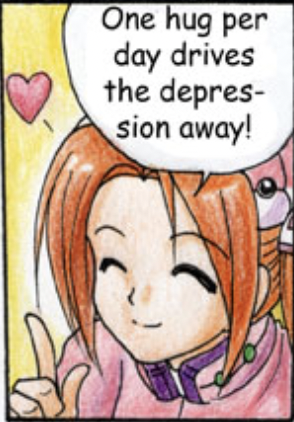
Genre: Sci-Fi
Rating: ᚦ

This comic is just dripping with early 2000’s anime edge. If you're looking for a Sasuke or Kaiba type character, you'll get a lot out of it.
For me, this comic has two big flaws: First, scene transitions are really awkward a lot of the time. There are often very sudden time skips and changes in location without much linking them to the previous scene. This is especially bad when moving from one chapter to the other, and I would sometimes become lost as to what was even happening because it was so disconnected from what had happened at the end of the previous chapter. Also the panel layout is sometimes hard to follow.
Second, the villain is really lame. He's like Tarkin from Order of the Stick: a manipulative psychopath who is supposed to come off as being extremely cunning, always having a plan, and always being one step ahead, but who actually comes off as a stupid, easily manipulated weakling who uses a god complex as a way to cope about his own insecurities and past failures. He's far, far below other 'god complex' characters like Light Yagami, that's for certain.
Actually, since this kind of character has come up more than once now, I think I should really explain what seperates Light Yagami from these guys. In Death Note, every inch of Light Yagami's strategies and double dealings are scrutinized in excruciating detail. The reader knows exactly how he formed his plan, where and how he got his information, and why he decided to use it the way he did. The reader is also made aware of all the possible ways Light's plans could (and frequently did) go wrong, as well as negative side effects of successful plans and unaccounted for or surprising variables.
In E-Depth Angel, and in Order of the Stick, information surrounding these plots are sparse. It's usually not until after the "gotcha!" moment comes that it's revealed to the reader there even was a plan. And, when it is revealed, only the fact that the villain had somehow predicted and prepared for everything is shown, rarely anything else.
For example, in one scene Angel and Kolei are communicating through text message in a way specifically designed to evade the cameras and other tracking devices Seon has around the vicinity. However, not long after, Seon reveals that he knows they were secretly texting and what the contents of those text messages were. How exactly did he find this out? I wish I could tell you.
Now lets see how an equivalent situation is handled in Death Note. L attempts to gather more information about Light and possibly get him to reveal that he is Kira by placing secret cameras and microphones in his room without his knowledge. However, Light discovers this, because he had a scrap of paper and a piece of pencil lead stuck in his doorframe to check for intruders, both of which were removed every time he went into his room. But this time, when he went in, he found that the hard-to-notice pencil lead was snapped, yet the scrap of paper had been carefully replaced. This gave him a sign that someone had entered his room and wanted to hide that information from him. Knowing this, he is therefore able to kill several people using the Death Note while avoiding the cameras by hiding a scrap of it in a potato chip bag.
Do you see the difference here? Death Note actually explains how Light knew about the cameras. Letting the reader know what the mastermind knows shows how he thinks and what his limits are. By keeping his plans too vague, all that happens is that a giant deus ex machina is created which, so long as the author wills it, can do anything, get him out of anything, and allow him to know anything, no questions asked. Without understanding how he forms his plans and gathers his information, all the reader has left to judge him on is his personality - and what comes to mind with both Tarkin and Seon is that they are enormously smug, overconfident, and hedonistic. Traits, you may notice, that are repressed or compeletely absent from Light Yagami, because they foster impulsive, reckless decision-making - not something a mastermind is typically known for.
I think the ending is also a little weak. It's certainly heartwarming, but I didn't quite feel fully satisfied. It felt like there were elements left hanging that shouldn't have been, for example I would have liked to see more of the results of the Pinnochio project and the wider effects of the discovery of a cure for Werner's Disease. Yeah, there's that one cyborg she got to see her promise fulfilled to when he smiled, but we don't see the efforts to help improve the run-down cyborg city, etc., and overall it just felt like it ended a bit too quickly.
As far as the art goes, I actually prefer the colored pencil used for the older pages over the digital art for the newer ones. There's not a whole lot of webcomics done in colored pencil and it looks really nice here. Wonderful mix of colors. The digital art feels a lot more generic, and, honestly, kind of sterile.
Angel herself is my favorite part about this comic. She's so cute! Her earnesty is really endearing. She’s brave, she’s strong, she’s doing her best despite her lack of power using the only weapon she has: compassion. The plot thread about her successfully managing to influence the main villain simply by getting him to like her is brilliant.
Best girl. If you’ve seen my shrine you’ll know that the “girly girl” archetype is typically the exact opposite of my tastes, but if anyone could sway me to the side of soft, pink giga-femininity, it would be Angel.
I’ll leave off this write-up with my favorite Angel line:
